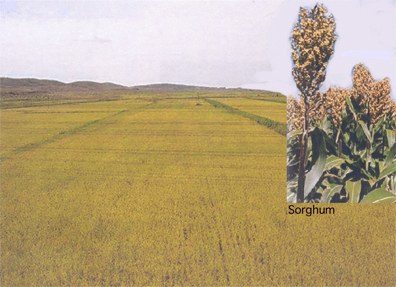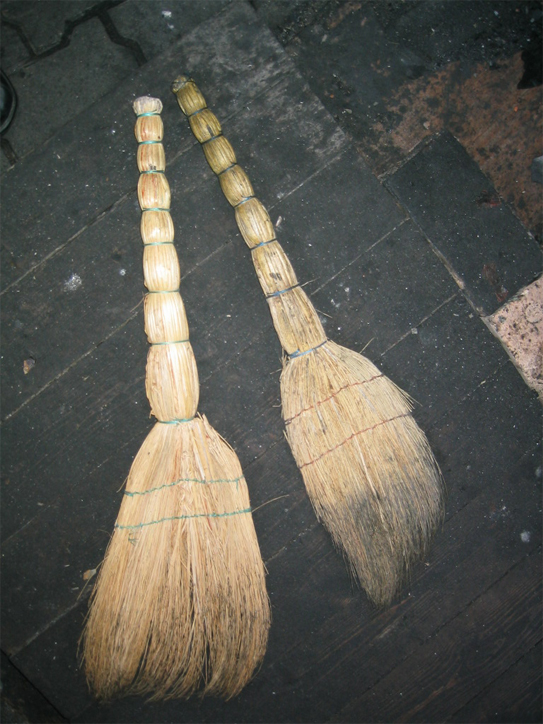

RECIPES
 RECIPE
#1
RECIPE
#1
--------
Sorghum Syrup
SOUTHERN US CUSINE: http://southernfood.about.com/library/weekly/aa101798.htm
>>To make the syrup, the cane is pressed to extract the juice then boiled down and evaporated to create a rich, golden syrup. This time of year you're likely to find molasses-making demonstrations and freshly bottled syrup in many areas of the South. Sorghum is still made not only to preserve the tradition, but also because is such a great favorite of Southerners. It's used pure or cooked to top biscuits and can be added to any recipe calling for molasses. It also has higher nutritional value than many of the other sweeteners.
The raw juice is poured through a burlap filter then into the wood-fired cooker.
The end result: Pure, golden sorghum syrup pours from the bubbling cooker and through another filter.<<
 RECIPE
#1
RECIPE
#1
Molasses Popcorn Balls
From Diana Rattray: http://southernfood.about.com/od/popcorntreats/r/bl81017c.htm
INGREDIENTS:
* 1 cup sugar
* 1/4 cup pure sorghum syrup
* 1/4 cup water
* 1 teaspoon salt
* 1 tablespoon butter
* 2 quarts popped popcorn
* butter, for hands and pan
PREPARATION:
In a 2-quart saucepan, combine sugar, sorghum syrup, water, salt, and butter. Cook to the hard ball stage (about 250° on candy thermometer), stirring occasionally. Remove from heat. Working quickly, stir in popped corn and turn into a buttered pan.
With buttered hands, shape into balls and place on waxed paper to cool.
Makes about 6 popcorn balls.
 RECIPE
#1
RECIPE
#1
Sorghum Ginger Snaps Cookies
From Diana Rattray: http://southernfood.about.com/od/molassescookies/r/bl81017a.htm
INGREDIENTS:
* 2 3/4 cups self-rising flour
* 1 teaspoon baking soda
* 1 teaspoon ground cinnamon
* 1 teaspoon ground ginger
* 1 cup light brown sugar, packed
* 3/4 cup butter or margarine, softened
* 1 egg
* 1/4 cup sorghum syrup or molasses
* granulated sugar, to coat cookie dough
PREPARATION:
Combine flour, baking soda, cinnamon, and ginger; set aside. Cream the sugar with the butter or margarine. Beat in the egg and syrup until light and fluffy. Stir in flour mixture just until blended.
Chill in the refrigerator for an hour or two.
Preheat oven to 375°. Shape dough into balls about 3/4-inch in diameter; roll in sugar to coat well. Place on lightly greased baking sheets about 2 inches apart, then flatten with the bottom of a glass dipped in the sugar. Bake about 8 to 10 minutes, or until set. Cool. Makes about 7 to 8 dozen cookies.
 RECIPE
#1
RECIPE
#1
Sorghum Pie
From Diana Rattray: http://southernfood.about.com/od/chesspies/r/bl81017e.htm
INGREDIENTS:
* 1 pie crust (9 inch)
* 5 eggs
* 1/3 cup sugar
* 1 1/4 cups pure sorghum molasses
* sweetened whipped cream for topping
PREPARATION:
Preheat the oven to 350° Line a 9-inch pie pan with the crust.
In a medium mixing bowl, with a hand-held electric mixer, beat eggs until smooth. Add sugar and sorghum, and beat for another minute.
Pour mixture into the pie shell. Bake for 35 to 40 minutes, until a toothpick inserted in the center comes out clean. Cool before serving.
Serve with sweetened whipped cream. Store leftovers in the refrigerator.
Sorghum Gingerbread
From Diana Rattray: http://southernfood.about.com/od/gingerbreadrecipes/r/bl81017d.htm
Serve gingerbread warm or cool, with whipped cream or a dessert sauce.
INGREDIENTS:
* 1/4 cup vegetable shortening
* 1/4 cup butter
* 1 cup hot water
* 1 cup sorghum molasses or regular molasses
* 3/4 cup sugar
* 1 1/2 teaspoons ground ginger
* 1 1/2 teaspoons ground cinnamon
* 1/2 teaspoon salt
* 2 teaspoons baking soda
* 2 3/4 cups all-purpose flour
* 2 large eggs, well beaten
PREPARATION:
In a saucepan combine the shortening, butter, water, molasses, sugar, ginger, and cinnamon. Bring to a boil, stir, then remove from heat and set aside to cool.
Sift flour, baking soda, and salt together.
Add cooled molasses and sugar mixture; stir until well blended. Stir in well-beaten eggs.
Pour into a generously greased and floured 9-x12-inch baking pan. Bake in a preheated 350° oven for about 25 to 35 minutes.
Makes 1 pan of gingerbread. Serve warm or cooled, with whipped cream or dessert
Sorghum Beer
 RECIPE
#1
RECIPE
#1
There was a recent article in the Okland paper about sorgum (sorghum) beer and is now found in part on William Brand's blog:
http://www.ibabuzz.com/beer/2006/11/08/169/
Background on Sorghum Beer
Posted by William Brand on November 8th, 2006
In my column today (Wednesday, Nov. 8, 2006, Oakland Tribune) I wrote about a new, gluten-free beer for people with an allergy to gluten in wheat, oats, rye and other cereal grains.
It's Dragon's Gold**** from the Bard's Tale Beer Co. in Lees Summit, MO, brewed under contract by Gordon-Biersch in San Jose, CA. It's made from malted sorghum, which a source at Gordon-Biersch tells me, contains no detectable gluten.
While researching sorghum beer, I discovered that beer made with sorghum is very popular in Africa, it's been brewed by Africans for hundreds of years. Most African sorghum beers, known as "opague" beers are brewed using wild yeast, can be somewhat sour and have a shelf life of only days. Sorghum, by the way, is a tropical grass that originated in Africa, it's now grown in warm areas around the world.
Here's a bit of info with links to my sources:
First, did you know..."Benjamin Franklin is credited with introducing broomcorn to the United States. While traveling in Europe, Franklin was impressed with a small broomcorn broom he used to clean his hat. He found a few seeds attached to the straw, and took them with him when he returned to Philadelphia. He planted the seeds and initiated an industry. Arcola, Illinois is known as the "Broom Corn Capital of the World." Since the late 1800's, area farmers grew the sorghum used in the broom industry. The broom corn is processed in Arcola and brooms sold across the country. Arcola holds an annual Broom Corn Festival each September."
Source: Southwest Biotechnology and Informatics Center.
Sorghum beer in Africa from Business Africa...
COMPANIES
SABMiller's new clear sorghum beer
Lynn Bolin
Wed, 02 Feb 2005
SABMiller, one of the world's largest brewers, has launched a new brand of clear sorghum beer, Eagle, which is aimed at helping African sorghum beer drinkers move up the beer ladder to clear lager by bridging the gap between the two.
The new brand was unveiled at a presentation on Wednesday by SABMiller's managing director for the Africa and Asia division, Andre Parker.
It has already been launched in Uganda, and is set to be launched in Zambia on April 1, as well as in Zimbabwe.
Looks like a normal lager
According to Parker, Eagle is a sorghum-based beer, but instead of the usual cloudy appearance, it is a look-alike to normal lagers, with the same alcohol level as well.
It is positioned to take advantage of the trend among African consumers to move to drinking clear beer as they move up the income scale...
...In Zambia, sorghum beer has a 60 percent share of the overall drinks market, with clear beer and carbonated soft drinks commanding only 20 percent each.
SABMiller already has a 50 percent share of the sorghum beer market via its Chibuku brand, and boasts 100 percent of the local clear beer market. Castle Lager is the largest brand in the country.
xxx
A tasting in Toronto of a South African sorghum beer with interesting comments about apartheid...
"Sorghum beer is generally only served in black bars, or black areas. Apartheid extended to the world of beer as the whites in South Africa drank the European-style brews of SAB, and blacks were allowed only to drink sorghum beer, at least until 1962.
Today sorghum beer still holds a strong market amongst the Zulu population of the region. Though commercially produced, they still maintain traditional methods. They are made from sorghum, not barley, and are not hopped. Fermentation is short, and finishes up after bottling. Some brands are packaged in milk cartons, which leak, and others in plastic bottles, which have a "breathing" mechanism in the top to allow fermentation gases to escape."
From Zulu Kingdom... The Zulu Beer Trail..
"The national drink of the Zulu people."
"Traditional beer brewing has been part of the Zulu culture for hundreds of years and still forms part of their heritage today. The "mild" sorghum beer is the national drink of the "African" people."
Handbook of Brewing (Food Science and Technology) by William Hardwick
Excerpt - on Page 41: " ... beer brewed in ancient Egypt and Mesopotamia. In South Africa, the Bantu tribes brewed a grain-based beer called kaffir or sorghum beer, after the grain employed in its brewing. Both sorghum beer and bouza are still brewed in rural Africa. ...
And finally, there's another sorghum beer being made commercially in the U.S. It's New Grist, made by Lakefront Brewing in Madison, WI. This excerpt comes from Ratebeer.com.
Find out more about New Grist from the brewery.
Commercial Description:
An all-sorghum beer. New Grist, a beer for Celiacs brewed from sorghum and gluten-free yeast grown on molasses. New Grist is the first "official" gluten free beer in the U.S., although it cannot technically be called "gluten-free" until established governmental guidelines are determined for all products claiming "gluten-free" status. In the interim, this Celiac-safe beer can be called "barley-free," and is a welcome product to those who need to live on restricted diets due to intolerance to gluten, a protein found in common brewing grains such as barley, wheat, rye, oats, spelt, kamut and triticale. <<
What is Sorghum and It's History:
SANDHILL FARMS; http://sandhillfarm.org/sorghum_FAQs.html
>>
What is Sweet Sorghum?
Sweet Sorghum, also called "sorgo," differs from grain sorghum in that it is grown for its stalk. Its grain yield (seed head) is low, and it is juicier and higher in sugar content. Seeing it growing in the field, you might say it looks like corn with its wide blade-shaped leaves arcing out in a whirl around the thick stalk. However, you'll find no ears and will notice a reddish tinge to the leaves, stalk and ripe seed head. Stalks stand up to 10 feet tall. A shorter version of this same plant, with a large seed head, is grown for livestock feed and is known as Milo.
The Sweet Sorghum we grow for Sorghum Syrup is from the Sorghum Bicolor race, Linn. Moench. Originally, a wild and early cultivated version of sorghum grew in flood conditions, and had many branches and heads. Sorghum came to be adapted to, and popular in, areas where it was too hot and dry to grow corn. It's adaptation to dry conditions is due to the fact that: it is able to remain dormant during drought and then resume growth; its leaves roll as they wilt thus presenting less surface for transpiration; its waxy leaves and stems protect from drying; and the large fibrous root system extracts moisture from soil.
Sorghum Syrup is made by cooking the juice from the stalk of the Sorghum plant. Sometimes Sorghum Syrup is called "sorghum molasses." This is confusing, because molasses is made from sugar cane and is a bi-product when granulated white sugar is taken out. Pure Sorghum Syrup has nothing added or taken out. It is true that some Sorghum Syrup producers add corn syrup or sugar cane syrup. Sandhill does not.
Where did sorghum originate?
Sorghum started in Africa and was carried to Asia and Europe before it arrived in North America. The Sorghum you see growing in our fields today is similar, but also very different from its wild ancestor growing in eastern and central Africa prior to 2000 BC. <<
-------
Wisconsin Corn Agronomy: http://corn.agronomy.wisc.edu/AlternativeCrops/SorghumGrain.htm
>> (Milo)
P. R. Carter1, D. R. Hicks2, E. S. Oplinger1, J. D. Doll1, L. G. Bundy1, R. T. Schuler1, and B. J. Holmes1
1. Depts. of Agronomy, soil Science, and Agricultural Engineering, Cooperative Extension Service and college of Agricultural and Life Sciences, University of Wisconsin-Madison, WI 53706.
2. Dept. of Agronomy and Plant Genetics, University of Minnesota, St. Paul, MN 55108.
November, 1989.
I. History:
Farmers on the hot, dry plains from Texas to South Dakota grow and use grain sorghum like Corn Belt farmers use corn. Large acreages of grain sorghum are also grown in Africa and Asia in areas where the climate is too hot and dry for corn.<<
----
SORGUM SYRUP
http://corn.agronomy.wisc.edu/AlternativeCrops/SorghumSyrup.htm
>>. History:
Sorghum (Sorghum bicolor L. Moench) is native to Africa, and many of today's varieties originated there. Sorghum was also grown in India before recorded history and in Assyria as early as 700 B.C. The crop reached China during the thirteenth century and the Western Hemisphere much later.
Sorghum was introduced to the United States from Africa in the early part of the seventeenth century. It was not grown extensively in this country until the 1850s, when the forage variety Black Amber (also called "Chinese sugarcane") was introduced from France. Since then many other varieties have been introduced from other countries or developed domestically.
Sorghum was grown primarily for syrup until the settlement of the semiarid West created a demand for drought-resistant forage crops. By the 1950s, about 90% of the acreage of sweet sorghums in the United States was grown for forage. Interest in sorghum syrup is renewed whenever a shortage of sugar results in higher sugar prices.
Sorghum production is concentrated in areas where the rainfall is insufficient and the temperatures are too high for profitable corn production. Thus most of the domestic sorghum acreage is in the southern Great Plains states, with Texas, Kansas and Nebraska the leading producers. However, some sweet sorghum has been grown for syrup or silage in Wisconsin and Minnesota.
II. Uses:
Sorghum syrup is extracted from the plant by crushing the stalk. The syrup is produced primarily in the United States and is used by the food industry as a substitute for sugar. Recent research has evaluated sorghum as a feed stock for production of ethanol. The grain from sorghum can be used as feed for poultry and livestock.
III. Growth Habits:
Sorghum is a coarse grass that grows as an annual in the Upper Midwest. Stems are erect and solid and reach a height of 2 to 12 ft. Syrup varieties grow to be 6 to 9 ft tall. In many respects, the structure, growth, and general appearance is similar to corn: stalks have a groove on one side between the nodes; grooved internodes alternate from side to side; a leaf is borne at each node on the grooved side, with the leaf sheath and blade arrangement also much like that of corn.
The buds that form at the nodes often develop into branches. Buds that form near the crown develop into grain-producing tillers. The tillers develop their own roots but remain attached to the old crown. The culms or stalks of some varieties and types of sorghum are juicy. If the pith is not juicy, the midrib of the leaf is white in color because of the air spaces in the tissues; when the air spaces are filled with juice, the color is more neutral. Because of this difference, the plants will be at different stages of maturity at the optimum time for harvest for syrup.
Another variation between varieties is the sweetness of the juice within the stalk. Sweetness is not related to juiciness; a dry-stalked sorghum can be either sweet or non-sweet, as can a juicy-stalked sorghum. Sugar content of the juice can range from 2 to 20%.
Sorghum leaves tend to fold rather than roll, as do corn leaves when subject to moisture stress. A heavy white wax (called "bloom") usually covers sorghum leaf blades and sheaths, protecting them against water loss under hot, dry conditions.<<
-----
There was a rule among German-Russians that nothing should go to waste. And, this was true of the soghum plant. Some of it was feed to the cattle while some of it was made into house brooms [Hofbesen].

From Alfred Hein's Photo Collection